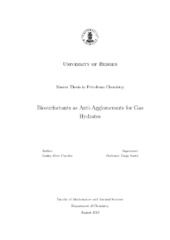Biosurfactants as Anti-Agglomerants for Gas Hydrates
Master thesis

View/
Date
2013-08-14Metadata
Show full item recordCollections
- Department of Chemistry [449]
Abstract
Gas hydrate blockages in petroleum pipelines are considered a major hazard in the petroleum industry, and with increasing water content and decreasing temperatures, a solution is sought upon that is both environmentally friendly and less costly than the current strategy. The application of biosurfactants at low concentrations in order to avoid agglomeration of hydrates in a cold flow, would significantly decrease environmental impact, in comparison to traditional thermodynamic inhibition methods. In this thesis, the hydrate anti-agglomerating effects at 500 ppm of commercial naphthenic acids, ARN-acids, and the glycosides octyl glucoside and lauryl maltoside were assessed through wetting index, interfacial tension and contact angle measurements on stainless steel. Out of these, lauryl maltoside was found to be the most promising at this concentration, showing a major decrease in adhesion energy on stainless steel in addition to an increase in the wetting index, a quantification of gas hydrate plugging risk, from negative (high plugging risk) to positive (low plugging risk). In addition, the sulfate reducing bacteria Desulfotignum toluenicum was cultivated for 7 and 10 months using toluene and crude oil as substrates. It was hypothesized that the bacteria would create water soluble biosurfactants that would change wettability characteristics of the cultivation medium. Adhesion energy was found to be reduced by bacteria present the media, to a larger degree for the medium where crude oil was used as a substrate rather than the medium where toluene was used as a substrate. The wetting index did not show any significant difference when the media were tested against a model oil. The small degree of influence of wetting properties was attributed to being an effect of low concentration. When tested against a crude oil rather than a model oil, the anaerobic biodegradation was found to have some effect on the wetting index, interpreted as slightly decreased risk of plugging. The bacteria was found to grow as a biofilm in the water/hydrocarbon interface, reducing the concentration of bacteria and organic matter present in the samples of the media that were used for testing.